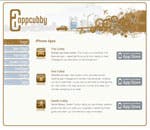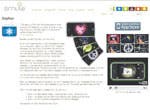Because of Apple’s tendency to name apps with an “i” prefix (iLife, iWork, iTunes, etc.), third-party app developers often follow suit. However, this naming convention can confuse iPhone users. For example, at first glance, there’s not much difference between iMob and iMafia.
When choosing a name for an app, you need something that is not only memorable, but also unique. The “memorable” part might tax your creativity, but don’t ignore the “unique.” For example, a colleague of mine developed a math game and he unknowingly gave it the same name as a math game for Windows! To avoid copyright infringement, I advised him to change it. Do research before you name your app, and not just on the App Store. Check out the United States Patent and Trademark Office (USPTO.gov).
You might also consider a name beginning with “A” so it pops to the top of alphabetized app lists. You can use a longer more descriptive name in iTunes, but for your ‘binary’ or actual program that runs on the iPhone or iPod touch, use a short product name so that it appears properly below the app icon in the Home screen. For example, “Star Wars: The Force Unleashed” shows up as “Star…eashed” under the icon. Yuck! A short app name avoids these issues.

Make your icon and logo stand out
![]() A lot of developers try to make their app icons or logos in the style of Apple’s icons. I suppose they think that associating their app with Apple adds credibility, but it misses one key point. Apple does not need to compete for market share or home screen real estate—third-party apps do!
A lot of developers try to make their app icons or logos in the style of Apple’s icons. I suppose they think that associating their app with Apple adds credibility, but it misses one key point. Apple does not need to compete for market share or home screen real estate—third-party apps do!
App icons need to be simple, attractive, and stand out from other apps
![]() App developers need to compete and their apps must stand out from other apps. Take a look at what Smule and AppCubby have done with their app icons (see graphics). In addition to developing quality apps, develop logos and icons that represent the app. If you develop a series of apps, make sure the icons tie them together in a clean, consistent, and elegant way.
App developers need to compete and their apps must stand out from other apps. Take a look at what Smule and AppCubby have done with their app icons (see graphics). In addition to developing quality apps, develop logos and icons that represent the app. If you develop a series of apps, make sure the icons tie them together in a clean, consistent, and elegant way.
Make good use of your Web site

 Use your Web site to both promote your app and address any common questions. Don’t make it an afterthought in the development process—a good Web site can help with both customer service and marketing. Note that Apple has been known to reject an app if the Web site associated with it is not active.
Use your Web site to both promote your app and address any common questions. Don’t make it an afterthought in the development process—a good Web site can help with both customer service and marketing. Note that Apple has been known to reject an app if the Web site associated with it is not active.
You can do a better job of selling your product on your own Web site, but be sure to include a link to the App Store so customers can buy your app.
If possible, get a domain name that matches the name of your app. When you come up with an app name, immediately check available domains using MyDomain.com or a similar site.
As with app names, try to keep the domain name short. This can be a challenge because many good, short domain names are often taken. If you run into this problem, add “app” to the end of the name. For example, if “MyGame.com” is taken, try “MyGameApp.com.”
When you structure your Web site, make sure it displays properly when accessed from an iPhone. This ought to be obvious, but many developers ignore this. Search Google for PHP or JavaScript code that you can incorporate to detect when your site is being accessed from the Mobile Safari browser, and automatically redirect the user to a “mobile” site designed for the iPhone’s smaller touch screen.
Many online ads for apps include a link that takes the viewer directly to the product listing in the App Store. You might consider directing them to your Web page instead. You can do a better job of selling the app on your Web site using Flash, graphics, and formatted text. You can also include a “Buy” link on your site that will take people to the App Store listing.
Finding the right price
Some developers like to experiment by starting out with one price, then lowering it, then raising it, and then repeating the process. Web sites like AppShopper.com and apps like AppSniper monitor app prices and alert users when there is a sale. Because of these, lowering the price can produce a surge in sales. On the other hand, some developers recommend raising an app’s price once it becomes successful. Their thinking is that there is a certain inertia associated with being in the top tier of apps, and a small price increase will not dramatically hurt unit sales.
Finally, many developers release a free version of their app to build up interest. Apple has strict requirements about these free versions. They may have a limited set of features, but they must be self-sufficient and they cannot require users to buy the paid version of the app to unlock features. Some developers offer free apps that include in-app advertisements to generate revenue. However, users can become frustrated by the ads and reviewers can be critical of them. This approach can backfire. Personally, I set pricing based on value and try to maintain it, rather than play games. I know consumers can get frustrated when they pay more for a plane ticket than the person next to them. So if you must change prices, try not to do so frequently or dramatically. If you do, it will show up in your reviews.
Doing business with Apple
The costs associated with developing and introducing an iPhone or iPod touch app are discussed in detail on Apple’s Web site (developer.apple.com). In summary, you’ll need to buy a Mac (approximately $600 for a Mac Mini), download the SDK (free), join Apple’s iPhone developer program ($99 a year), and purchase an iPhone or iPod touch ($varies).
You’ll also need to provide Apple with bank account information so you can receive your profits. You’ll receive separate money transfers from each country in which Apple operates, and you won’t get your first payment until about six weeks after you have earned at least $250 in a particular country’s iTunes store. Find out now if your bank charges for international wire transfers. Some bank fees can be hefty.
If you want to stay on top of your sales figures, check out AppFigures.com, a Web-based service that will track your sales and e-mail reports on a regular basis.
App Store Trends
The App Store is so new that it’s hard to draw too many conclusions, but here are some trends I have been able to observe:
- Saturday and Sunday sales are typically 20% to 50% higher than weekday sales.
- Christmas is a blessing. We were fortunate to have our first app, 100sounds, approved on December 12th and make it into the Top Ten for Entertainment just in time for December 25th and 26th, two of our biggest days, with over 2,000 copies sold each day!
- Being in the Top Apps list is a huge benefit and you might want to be creative in this regard. For example, it’s difficult to break into the Top 25 for Entertainment or Games. If you’re on the fence about which primary category to choose, you might be better off being a big fish in a smaller pond and select a category like Utilities where there’s less competition.

